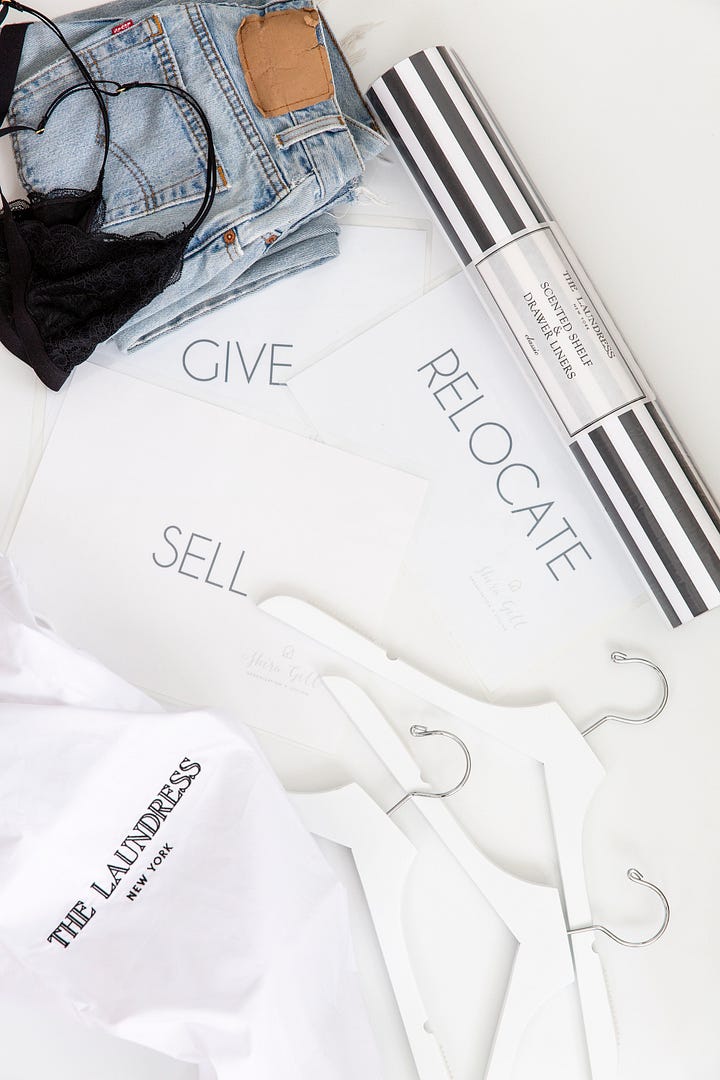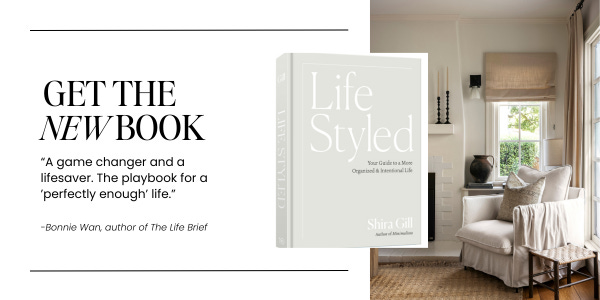How to Stop Buying Things You Don't Need
On breaking the habit of overconsumption
I’m thrilled to introduce The How-To Series — five weeks of thoughtful, practical tips to help you clear clutter, get organized, and create more ease in your everyday life. I hope you’ll follow along and share with anyone who might enjoy it. All paywall-free, as always.
There are way too many cardboard boxes by my front door, which feels off-brand and a bit shameful to admit, but here we are. Sometimes I shop when I’m inspired or really need something, but more often than not, I tend to buy things when I’m feeling off in some way—lonely, restless, bored, or anxious.
I’ve written a lot about how to declutter, but not enough about how to get to the root cause of our desire to consume in the first place.
As one reader wrote to me recently: It’s wild to me how much is out there content-wise around decluttering and how relatively little support there is around breaking the pattern of overconsumption.
Challenge accepted: I’m going to break down the most common shopping triggers I see in my work (and life) and then reveal the one simple shift you need to make to break your over-shopping habit for good.


The Most Common Shopping Triggers
Which resonate for you? What did I miss?
The If/Then Fallacy - You convince yourself that if you just had the right planner, organizer, or storage system, then you’d finally get your life together—so you keep buying solutions to problems you may not even have.
The Boredom Spend - You feel restless or bored and find yourself adding things to your cart to get a little dopamine hit, turning idle time into a pile of things you don’t need.
The Insecurity Splurge - You see someone else’s life, style, or home and feel inadequate by comparison, so you shop to close the gap between who you are and who you think you should be. Spoiler: this never works because material items can never solve for insecurity - it’s an inside job.
The Shopping Spiral - The “Now that I have A, I need B to go with it” trap. I need new shoes to go with these pants; I need a belt to go with this dress; etc. etc.
The Identity Shift - You’re trying out a new version of yourself (a new you who runs marathons, or bakes sourdough, or knits sweaters, or…) and you buy all the props before you’ve actually committed to the lifestyle or habit.
The Avoidance Habit - There’s something uncomfortable you need to face, like a difficult conversation or a looming deadline, so you distract yourself by researching and purchasing things you don’t actually need. Unfortunately avoidance behaviors (over-eating, over-drinking, over-shopping) alway catch up with you.
The Perfect Minimalist Trap - You want the perfectly curated wardrobe, the ideal minimalist home, fewer, better of everything, but your quest for “just right” turns into endless research, obsessive comparisons, and way too many purchases (and returns) as you try to buy your way to the holy grail of minimalism (hand up, guilty as charged).
The Singular Solution:
Here’s the great news—no matter what your specific shopping trigger is, the solution boils down to one thing: being willing to sit with discomfort.
I know it sounds almost too simple to work, but hear me out.
Every time we reach for our phone to browse, add something to cart, or click “buy now,” we’re essentially trying to solve a feeling. We’re bored, so we seek stimulation. We’re anxious, so we seek control. We’re feeling inadequate, so we seek transformation through objects that promise to make us better, more organized, more stylish, more complete.
The thing is, buying something new only works temporarily. It gives us a quick hit of dopamine, a brief sense of agency, a momentary distraction from whatever we’re actually feeling. Which is exactly why we keep doing it. Over and over again. Our brains learn: discomfort → purchase → relief. The pattern deepens with every repeat.
Breaking this cycle doesn’t require perfect willpower or complex strategies. It requires practicing something radically simple: pausing long enough to feel what you’re feeling without immediately trying to fix it.
Here’s what this might look like:
Noticing the urge to shop and getting curious about what triggered it instead of opening your browser
Adding items to cart; leaving items in cart
Sitting with the restlessness or anxiety for five minutes before reaching for your credit card
Letting yourself be bored without immediately seeking stimulation through consumption
Shopping your own home - getting creative with what you already have to recreate looks you love, whether that’s rearranging furniture and accessories or remixing your wardrobe in new ways
Taking a moment to appreciate something you already own by actually using it - eating breakfast from that pretty ceramic bowl, wearing your favorite sweater, revisiting a beloved book
Gamifying it - every time you feel the urge to buy something you don’t need, setting aside that exact amount of money to invest in your savings or retirement account or donate to your favorite charity or organization
Finding healthy feel-good alternatives to shopping that result in a net positive: a brisk walk, five minutes in nature, a phone call with an old friend, making something, baking something - you get the idea
The discomfort won’t harm you. In fact, the feeling usually passes within minutes if you let it. And, each time you practice sitting with it rather than shopping through it, you weaken the neural pathway that links your emotions to your wallet. You prove to yourself that you can tolerate uncomfortable feelings without needing to buy your way out of them.
This doesn’t mean you’ll never shop again or that every purchase is problematic. It means you’ll start to distinguish between buying something because you genuinely need or love it, versus buying something to escape a feeling.
Next time you feel the pull to buy, try this: close the tab. Set a timer for five minutes. Sit with whatever comes up. Write it down. Breathe. You might be surprised at what you discover.
READER PROMPT: Have you found ways of curbing overconsumption or shopping more intentionally? Please share in the comments below.
New Podcast: I loved being a guest on The Women on the Verge of a Financial Breakthrough podcast to talk about why we own too much stuff and what to do about it. Listen here.
Good Housekeeping Feature: I weigh in on the house hushing trend - read it here
On My Wishlist: Dear New York - a beautiful book of portraits and stories from every corner of my favorite city!
Big YES to This: How to Have an Analogue Fall via
1:1 Business Mentoring: No-fluff strategy and support to help you tackle your large and small goals. Get support here
My Signature Online Course: Learn how to edit, organize, and elevate your home like a pro. To the course
Curated Product Recs: My fewer better faves for your home, life, and wardrobe. To the recs
I Wrote Some Books: Actionable strategies to clear clutter, get organized, & elevate your home and life. To the books
Order LifeStyled now from your favorite bookshop! bookshop | target | amazon | barnes and noble | signed copies - now available in the UK, Australia, and New Zealand






To help me from buying things I don’t need, I make it a habit to remove myself from various retail email lists as soon as I receive. Then I am not triggered by the latest Sale or Must Haves.
The first thing I always tell potential clients or friends struggling with there homes is find inspiration and go from there. So I decided to take my own advice and applied the same mantra to fashion. Lately, I've been in that rut where I hate EVERYTHING in my closet. So Sunday afternoon, I spent some time following some of my favorite fashion guru's. Watching how they style clothes and then I headed into my closet to see how I could accomplish similar looks with the clothing I already have. Shockingly, I was able to pull together a few outfits I'd never thought about.